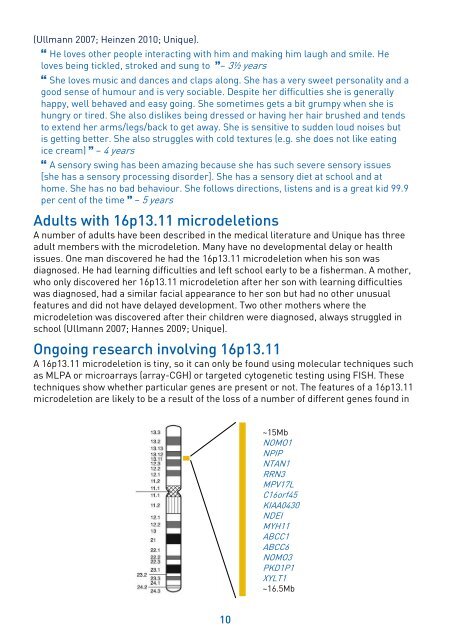16p13.11 microdeletions - Unique - The Rare Chromosome ...
16p13.11 microdeletions - Unique - The Rare Chromosome ...
16p13.11 microdeletions - Unique - The Rare Chromosome ...
You also want an ePaper? Increase the reach of your titles
YUMPU automatically turns print PDFs into web optimized ePapers that Google loves.
(Ullmann 2007; Heinzen 2010; <strong>Unique</strong>).<br />
He loves other people interacting with him and making him laugh and smile. He<br />
loves being tickled, stroked and sung to – 3½ years<br />
She loves music and dances and claps along. She has a very sweet personality and a<br />
good sense of humour and is very sociable. Despite her difficulties she is generally<br />
happy, well behaved and easy going. She sometimes gets a bit grumpy when she is<br />
hungry or tired. She also dislikes being dressed or having her hair brushed and tends<br />
to extend her arms/legs/back to get away. She is sensitive to sudden loud noises but<br />
is getting better. She also struggles with cold textures (e.g. she does not like eating<br />
ice cream) – 4 years<br />
A sensory swing has been amazing because she has such severe sensory issues<br />
[she has a sensory processing disorder]. She has a sensory diet at school and at<br />
home. She has no bad behaviour. She follows directions, listens and is a great kid 99.9<br />
per cent of the time – 5 years<br />
Adults with <strong>16p13.11</strong> <strong>microdeletions</strong><br />
A number of adults have been described in the medical literature and <strong>Unique</strong> has three<br />
adult members with the microdeletion. Many have no developmental delay or health<br />
issues. One man discovered he had the <strong>16p13.11</strong> microdeletion when his son was<br />
diagnosed. He had learning difficulties and left school early to be a fisherman. A mother,<br />
who only discovered her <strong>16p13.11</strong> microdeletion after her son with learning difficulties<br />
was diagnosed, had a similar facial appearance to her son but had no other unusual<br />
features and did not have delayed development. Two other mothers where the<br />
microdeletion was discovered after their children were diagnosed, always struggled in<br />
school (Ullmann 2007; Hannes 2009; <strong>Unique</strong>).<br />
Ongoing research involving <strong>16p13.11</strong><br />
A <strong>16p13.11</strong> microdeletion is tiny, so it can only be found using molecular techniques such<br />
as MLPA or microarrays (array-CGH) or targeted cytogenetic testing using FISH. <strong>The</strong>se<br />
techniques show whether particular genes are present or not. <strong>The</strong> features of a <strong>16p13.11</strong><br />
microdeletion are likely to be a result of the loss of a number of different genes found in<br />
~15Mb<br />
NOMO1<br />
NPIP<br />
NTAN1<br />
RRN3<br />
MPV17L<br />
C16orf45<br />
KIAA0430<br />
NDEI<br />
MYH11<br />
ABCC1<br />
ABCC6<br />
NOMO3<br />
PKD1P1<br />
XYLT1<br />
~16.5Mb<br />
10

















